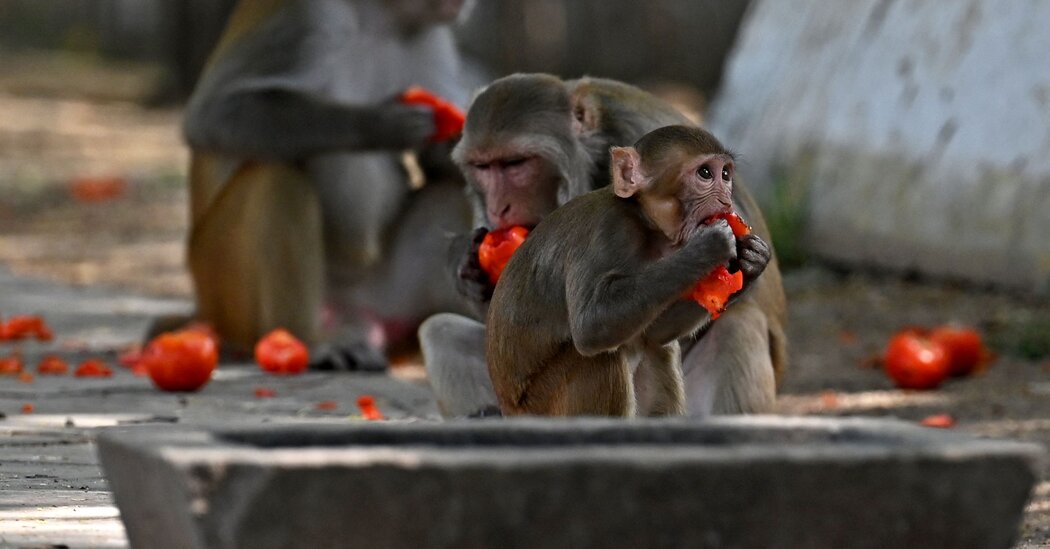If you’re ever in New Delhi and think you hear a monkey, don’t assume it’s a monkey. It could be a professional monkey noise impersonator.
That’s because humans have been trained to imitate the guttural grunts and shrieks of gray langurs, a type of large monkey that can scare away the smaller kinds that tend to invade city officials’ residences or disrupt state visits.
This weekend, the impersonators will take on a fresh challenge: keeping monkeys, which often evade guards by swinging through tree canopies, from barging into venues for the Group of 20 summit of world leaders, the first to take place in India.
The event is an important one for India on the global stage, and the government does not want monkeys to steal the spotlight.
“We are trying everything to keep the monkeys away,” Satish Upadhyay, vice chairman of the New Delhi Municipal Council, said in an interview. The campaign includes training 40 people to imitate langur noises and placing life-size cutouts of the animals, which can weigh more than 30 pounds, around the venues.
Every place has its unique challenges in hosting a large and prestigious event. Gatherings like the 2010 G20 summit in Toronto and the 1999 World Trade Organization meeting in Seattle were disrupted by protests. Before their turns hosting the Olympics, Beijing, Paris and Salt Lake City tried to hide poor and homeless residents.
New Delhi, too, faces problems including air pollution and its reputation as a city that is unsafe for women. Amid India’s G20 promotional blitz, advocates say the city’s poor have been hidden away.
And then there are the wild monkeys, mainly rhesus macaques.
They are not shy. They steal food and chase pedestrians. They sometimes ride buses and subway trains. They have attacked patients inside hospitals, invaded the Defense Ministry and the prime minister’s office and romped in the Indian Parliament building.
Such antics occasionally have deadly consequences. In an extreme case, a deputy mayor died in 2007 after falling from his balcony while trying to scare away monkeys by using a stick.
“The monkeys are naughty and they can arrive at your dinner table, in any house in Delhi,” said Abdul Khan, a freelance monkey noise imitator in New Delhi, whose uncle once used live monkeys to shoo smaller ones. “It doesn’t matter how many security guards you have outside the gate.”
A number of Indian and overseas news outlets kicked off their coverage of the G20 last week with reports on the government’s plans for scaring off the macaques. Manisha Pande, the managing editor at Newslaundry, an Indian media watchdog, said such coverage was “as clichéd as it gets” and that many Indians were “quite bored of the foreign press regurgitating the same monkey story.”
She said she could not recall any event or summit in the country ever being disrupted by monkeys.
“That said, monkeys are known to be a bit of an urban menace when it comes to Delhi and many other cities of South Asia and Southeast Asia, just like sea gulls are a menace in any coastal European city,” she said.
Deploying monkey noise impersonators during state visits and other important functions is a relatively new tactic in Delhi, and it is a far less aggressive one than those city authorities used in the past: human monkey chasers and actual gray langurs, not to mention slingshots, stones and tranquilizer guns.
In 2012, the national government banned the use of actual langurs, after activists said the practice amounted to animal cruelty. Most of those langurs were captured from the wild in violation of Indian laws, said Valentina Sclafani, a psychologist at the University of Lincoln in Britain who has studied primate behavior.
Another challenge is that in Hinduism, India’s dominant religion, monkeys are viewed as representations of a deity, and some people like to feed them as a traditional offering.
So Delhi officials began looking for other options. Langur voice mimickers, for instance, were part of a larger effort to tidy up Delhi’s rough edges ahead of President Obama’s 2015 state visit.
Does such mimicry actually work, though?
Emily Bethell, an expert on primate behavior and social cognition at Liverpool John Moores University in Britain, said that she had found no peer-reviewed studies on langur voice mimicry being an effective strategy for containing a macaque population.
Still, she said, the practice appears to be based on a sound understanding of macaque behavior.
“Whether they can mimic those calls so closely that a macaque would interpret them as coming from a langur we cannot know without rigorous scientific testing,” Dr. Bethell said in an email. “However, the macaques may be familiar with humans making these calls and associate them with threat, which could be enough.”
Dr. Sclafani also expressed cautious optimism about the practice, saying there is some evidence that macaques can recognize and respond to langurs’ alarm and territorial calls under certain conditions.
A hypothetical monkey disruption at the G20 could threaten the government’s “meticulously built” reputation for event management and give the political opposition fodder to attack Prime Minister Narendra Modi’s governing party ahead of upcoming state-level elections, said Sanjeev M.A., a professor of marketing at the Jaipuria Institute of Management in Lucknow, India, who has studied crisis communication by Indian officials during the coronavirus pandemic.
If any monkeys were to be killed, he added, that would upset members of India’s Hindu majority and allow the opposition to question the government’s religious sensitivities.
Mr. Upadhyay, the municipal official, declined a reporter’s request to interview some of the impersonators. He said their work was part of continuing research by forestry officials to find new ways of scaring off monkeys.
He expressed confidence in the impersonators’ chances of success at the G20.
“Will it be 100 percent effective?” he said. “It doesn’t work that way.”











